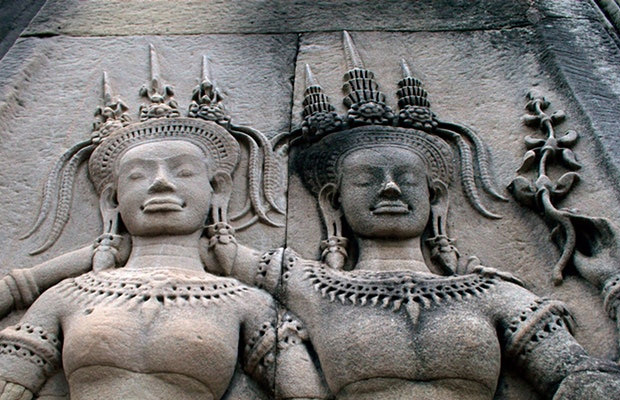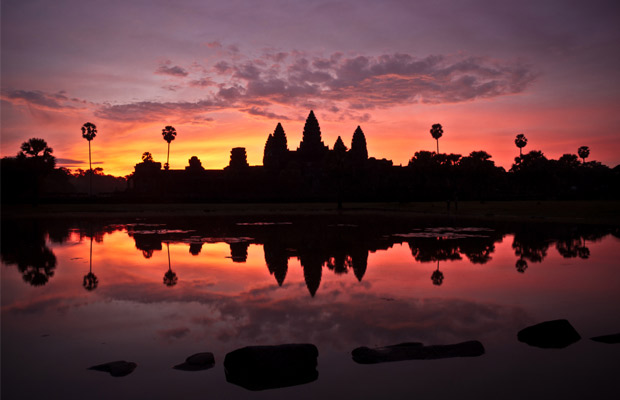Preah Khan Temple
Preah Khan Temple is located 2 km northeast of Angkor Thorn on the Grand Circuit. The temple was built in the second half of the 12th century AD in AD 1191 by King Jaya-varman VII, dedicating to his father Dharanindravarman. The Buddhist complex covers 56 acres served as the nucleus of a group that includes Neak Pean and Ta Som, located 4 miles long Jayatataka Baray - the last of the large resguardos to be built in Angkor.
Preah Khan Temple is located 2 km northeast of Angkor Thorn on the Grand Circuit. The temple was built in the second half of the 12th century AD in AD 1191 by King Jaya-varman VII, dedicating to his father Dharanindravarman. The Buddhist complex covers 56 acres served as the nucleus of a group that includes Neak Pean and Ta Som, located 4 miles long Jayatataka Baray - the last of the large resguardos to be built in Angkor.
The inscription indicates that Preah Khan was built on the battle site where King Jaya-varman VII finally defeated the Chams. At that time, it was known as Nagarajayacri, which means the city of Preah Khan.
Four concentric walls subdivide Preah Khan. The outer or fourth wall, which is surrounded by a large moat, now encompasses a large expanse of the jungle, formerly dwellers of the monks, students and attendants of Preah Khan. The second ramp delineated the main religious compound of about four hectares within which there is a dense concentration of temple and shrines. The central complex is Buddist. The northern and western sectors are dedicated to
Brahmanism - Vishnu (west) and Shiva (north), while the southern sector is a place of worship of the ancestors. The eastern sector forms the grand entrance of the central shrine.
A place for a king located near the temple of Preah Khan is called Veal Reacheak or Preah Reachea Dak. It is 1,500 meters long and 1,200 meters wide. About 700 meters north of the Preah Khan temple, along the road to the district of Angkor Thorn, is another small temple called Ptu. The temple was made of laterite.
The History of the Temple of Preah Khan
Preah Khan was built on the site of Jayavarman VII's victory over the invading Chams in 1191. Unusually, the modern name, meaning "sacred sword", is derived from the meaning of the original Nagara-Jayasri (sacred city of victory). The site may already have been occupied by the royal palaces of Yasovarman II and Tribhuvanadityavarman. The stele of the temple base provided considerable information about the history and administration of the site: the main image of the bodhisattva Avalokiteśvara in the form of the king's father was dedicated in 1191 (the king's mother had already been celebrated in the same way in Ta Prohm). 430 other deities also had sanctuaries on the site, each of which received a portion of food, clothing, perfumes and even mosquito nets; The wealth of the temple included gold, silver, gems, 112,300 pearls and a cow with golden horns. The institution combined the roles of city, temple and Buddhist university: there were 97,840 attendants and servants, including 1000 dancers [5] and 1000 teachers.
The temple is not yet redeemed: initial deforestation was from 1927 to 1932, and partial anasthylosis was performed in 1939. Since then, independent statues have been removed for maintenance and there have been further consolidation and restoration works. At all times, the conservatives tried to balance the restoration and maintenance of the wild condition in which the temple was discovered: one of them, Maurice Glaize, wrote this;
The temple was previously invaded with a particularly voracious and quite ruined vegetation, presenting only the chaos. Compensation work was carried out with constant respect for the large trees which give the composition a pleasant presentation without constituting an immediate danger. At the same time, a partial anasthenosis revived several buildings found in a state of sufficient preservation and exhibiting some special interest in its architecture or decoration.
Since 1991, the site has been maintained by the World Monuments Fund. He continued with the cautious approach of restoration, believing that going further would involve a lot of divination and prefers to respect the ruined nature of the temple. One of his former employees said, "We're basically running a glorified maintenance program. We're not prepared to fake the story." It was therefore limited mainly to stabilization work in the fourth eastern gopura, the Firehouse and the Dancers' Hall.
View Mores Temple Guide

Preah Vihear Temple
Preah Vihear Temple (Khmer: ប្រាសាទព្រះវិហារ Prasat Preah Vihea) is an ancient Hindu temple built during the period of the Khmer Empire, which sits atop a 525-meter ...
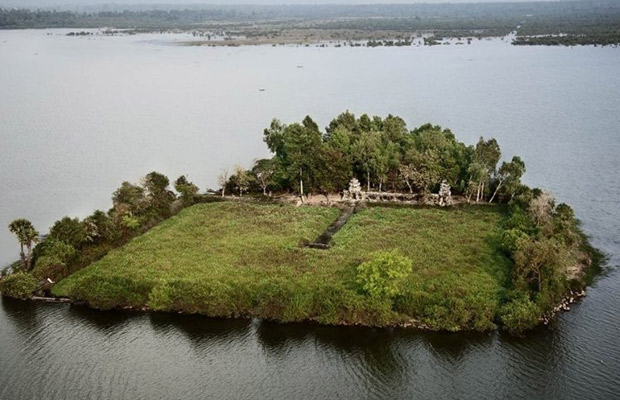
West Baray
The West Baray (Khmer: បារាយណ៍ទឹកថ្លា, Baray Teuk Thla) is a baron or reservoir, in Angkor, Cambodia, oriented to the east and west, located west of the walled city, ...

Terrace of the Elephants
The Elephant Terrace (Khmer: ព្រះ លានជល់ដំរី) is part of the walled city of Angkor Thom, a ruined temple complex in Cambodia. The terrace was used by Angkor King, ...

Khleangs(North Khleang and South Khleang)
The Khleangs are two buildings of unknown purpose on the east side of Royal Square in Angkor Thom, Cambodia, located just behind the twelve towers of Prasat Suor Prat and separated by the royal route ...
.jpg)
Angkor Wat Temple
Since the "discovery" of the temple of Angkor Wat, released in the mid-19th century, it was described as the largest religious building in the world and is rightly spoken as one of the wonders of the ...
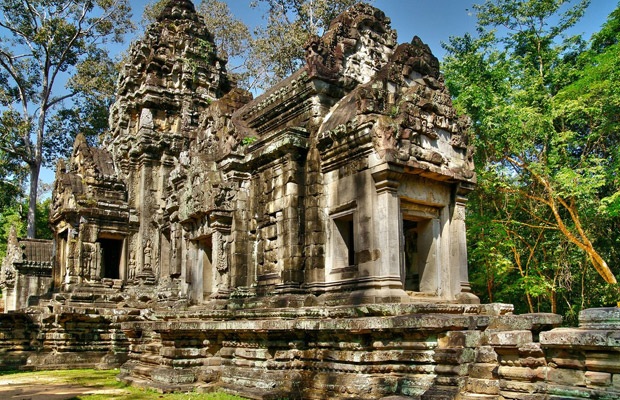
Thommanon
Thommanon is one of two Hindu temples built during the reign of Suryavarman II (1113-1150) in Angkor, Cambodia. [1]: 119 This small and elegant temple is located east of the Victory Gate of Angkor ...
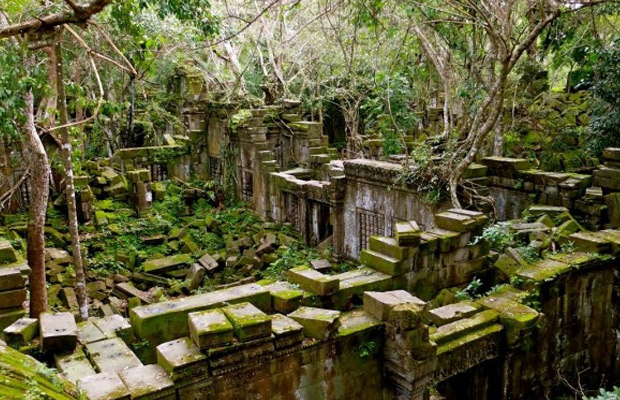
Beng Mealea
Beng Mealea or Bung Mealea (Khmer: ប្រាសាទបឹងមាលា, the name means "lotus pond" [1]) is a temple in the Angkor Wat period [2]: 118-119 located 40 km east of the main group ...

Prasat Bei
Prasat Bei (Khmer: ប្រាសាទបី) means "three temples", is a temple with three brick towers in a north-south row, facing east and standing on a laterite platform. The central tower ...

Prasat Chrung
Prasat Chrung (Khmer: ប្រាសាទ ជ្រុង) are temples that are located in every corner of Angkor Thom, in the landfill that comes almost to the top of the walls, is a small temple ...

Cambodia Culture Village
The Cambodian cultural village situated in the province of Siem Reap along the number 6 road distanced itself 3 km from the International Airport of Siem Reap and 5 km from the temple of Angkor Wat, ...
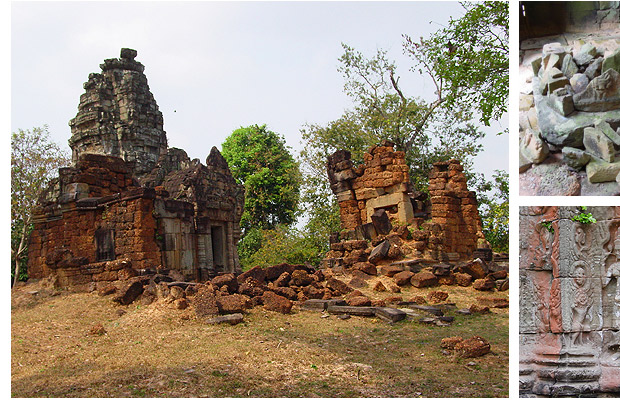
Prasat Prei
Small temple ruins unite in a forest setting near Neak Pean. Remains of a gopura, the central tower and halls, and the vestiges of a library and surrounding wall. Some apsara and lintel sculptures. A ...
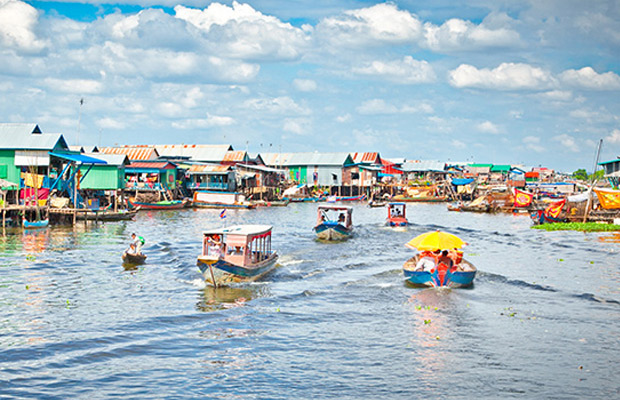
Chong kneas floating village
It is a kind of long and seaport canal about 12 km from Siem Reap, flanked by brown-green seats scrubbed to the west side from which you can see the edges of a part of the floating forest that makes ...





